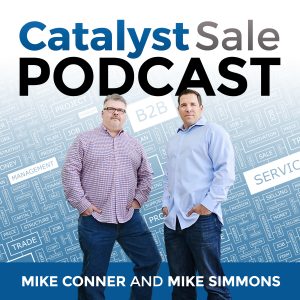Key Performance Indicators - what works, what doesn't, and where to start
This week we have a listener question from Jared in Florida. Jared is questioning the KPIs that are being measured by the organization and wonders how do you determine if you are measuring the right things.
When it comes to sales, most of us are ultimately measured by performance vs. the number we are accountable to deliver. Performance vs Quota or Plan is a good measure of success on a monthly, quarterly, and annual basis depending on your product, solution, or service. What if you want to go beyond the financials? What are some of the other metrics you can track to illustrate or confirm success/failure?
It has been said many times, most attributed to Peter Drucker - "what gets measured gets managed." It has also been our experience that you need to be careful what you measure, because it may create unintended consequences.
When thinking about KPIs, begin with the end in mind. From a traditional sales perspective, you can look at each stage in the funnel, have a clear set of objectives and expectations, measure performance against each stage, and identify gaps/risk. As an example, we use
Traditional Sales KPIs include
- Performance vs Plan
- Performance vs Previous Year
- Cost of Sale
- Number of Opportunities Created
- Number of Proposals delivered
- Number of Presentations delivered
- Number of Calls Made
- Number of Meetings Scheduled
- Number of Prospects
Identifed - Number of Pilots/Trials Started
What happens if you are pre-revenue, or you are still in the process of confirming product market fit? You can apply KPIs to user behavior. As an example in a SaaS based product where engagement is expected, you may want to consider the following metrics.
User Behavior KPIs can include
- Number of times a user shares content
- Number of times a user clicks shared content
- Number of times a user views content
- Number of times a user enters the site per day/month/quarter
- Number of new users who access the product per day/month/quarter
- Number of users who return to the product per day/month/quarter
- Number of times a user performs X behavior
When we think of these metrics we usually begin with the end in mind, what is the desired behavior, desired state, how do we measure success, what do we expect to see to indicate success.
Frequency
Once the KPIs are defined, the next step is to establish frequency. Is it critical that you look at your KPIs on a daily basis? Depending on the business, it may be necessary. KPIs should be segmented into Daily (if necessary), Weekly, Monthly, Quarterly, & Annual segments. Investing time in the process of establishing KPIs, and tracking them over time, will help you to identify where you are succeeding, and where there are opportunities for improvement.
Many times we have seen situations where KPIs are established but are not being measured consistently. This lack of consistency makes it difficult to evaluate success and make decisions based on data.
Personal KPIs
As an individual contributor, you can establish your own set of KPIs. If you are interested in doing so, make sure they align with the organization's objectives. Communicate with your leadership team and colleagues to validate what you are measuring. Continue to evaluate the viability of the measures, and share the data with your leadership team as you identify interesting trends. Establishing individual KPIs can keep you on track, and drive performance.
When KPIs are known throughout the organization. Performance vs Plan is shared, an environment can be created where the team (organization) is working toward a common goal. There is nothing like being on a team who is in the know, who is brought in, and who is working toward a common objective.
Thank you for listening to this week's podcast. If you have questions about the Catalyst Sale approach, KPI definition, or have a question you would like us to answer on the podcast, you can reach us at hello@catalystsale.com or, schedule a call with us to discuss our practice areas.
Please send listener questions and feedback to hello@catalystsale.com or contact us directly on twitter, facebook or LinkedIn.
Subscribe to the Catalyst Sale Podcast
Catalyst Sale
In every business,


